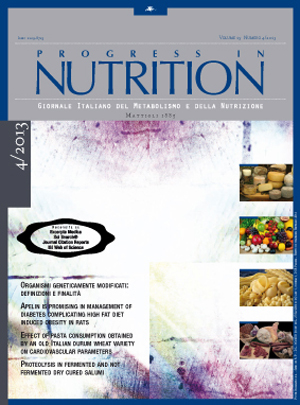Chemical and nutraceutical profile of italian onion (Allium cepa L.) organic-grown genotypes
Keywords:
Unsaturated sulfur volatiles, soluble sugars, vitamin C, quercetins, antiradical capacity, anthocyanins, GC-MS and HPLC analysis.Abstract
The aim of this study was the evaluation of quality parameters in four onion genotypes named “Suasa” and “Precoce di Romagna”, landraces typical from Marche and Emilia Romagna region, respectively; “Tropea”, a commercial cv and “Density”, a commercial hybrid. All genotypes have been cultivated in 2011 season on 11 years organic-converted soils. All samples, harvested at commercial ripening, have been subjected to some quality aspects as follows. Chemical quality: soluble sugars, unsaturated and saturated sulfur volatile compounds. Nutraceutical quality: unsaturated sulfur volatile compounds, ascorbic acid, quercetins, anthocyanins, polyphenols by Folin-Ciocalteau reaction, and antiradical capacity. The attention was particularly focused on unsaturated volatile sulfur compounds for their anti-carcinogenic effect. Moreover, quercetins are noted for their antiradical capabilities. The saturated sulfides content ranged 1282-1705 μg/100g dm for all genotypes, with the exception of Suasa (938 μg/100g dm). The unsaturated sulfur substances content ranged 3188-3716 μg/100g dm for Density, Tropea and Precoce di Romagna, while a lower amount for Suasa, 1917 μg/100g dm was ascertained. Quercetins, highly correlated with antiradical activity (rxy=0.94), revealed high content in Density and Tropea (43.3 and 30.6 mg/100g fw), and low amount in Precoce di Romagna and Suasa (13.1 and 11.4 mg/100g fw). The potential anti-tumor activity, given by unsaturated sulfur substances, resulted better in all genotypes than Suasa, with an high antiradical potential in Density and Tropea.Downloads
Published
Issue
Section
License
This is an Open Access article distributed under the terms of the Creative Commons Attribution License (https://creativecommons.org/licenses/by-nc/4.0) which permits unrestricted use, distribution, and reproduction in any medium, provided the original work is properly cited.
Transfer of Copyright and Permission to Reproduce Parts of Published Papers.
Authors retain the copyright for their published work. No formal permission will be required to reproduce parts (tables or illustrations) of published papers, provided the source is quoted appropriately and reproduction has no commercial intent. Reproductions with commercial intent will require written permission and payment of royalties.

This work is licensed under a Creative Commons Attribution-NonCommercial 4.0 International License.


